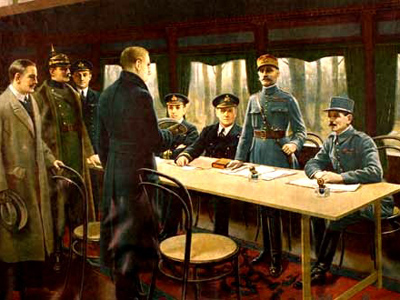
Ask the AI Tutor
Need help with World War One: 1914-18 - The Armistice Of November 1918? Ask our AI Tutor!
AI Tutor - Lucy
Connecting with Tutor...
Please wait while we establish connection

The Armistice which brought World War One to an end was signed in a railway carriage.
World War One: 1914-18 - The Armistice Of November 1918
Discover how military defeat, revolution in Germany and Allied pressure came together to end the First World War with the Armistice of November 1918.
1 .
Which of the German commanders below urged an armistice and the abdication of the Emperor William II, in order to save Germany from an even worse fate?
Field Marshal Hindenburg
The Crown Prince ("Little Willie")
Bethmann-Hollweg
The Duke of Wurttemberg
The German elite were anxious that a communist revolution would erupt in Germany, following the Bolsheviks' success in Russia. Thus some of them felt that a ceasefire could avoid this situation
2 .
Which of the following descriptions best conveys the meaning of the word "armistice"?
A ceasefire for a defined period, after which hostilities would resume
A surrender guaranteed by the payment of a substantial indemnity
A ceasefire pending the signing of a definitive peace treaty
The withdrawal of German forces to German territory, but without disarmament measures
Technically, Germany had not been defeated. Both sides cherished their own interpretations of what an "armistice" signified
3 .
What was the name of the large town in Northern France near where the Armistice was signed?
Abbeville
Amiens
Compiegne
Hazebrouck
Since the spring of 1918 the Western Allies had been advancing, as they repulsed the final German offensive. They still had not, however, reached the German border before the German high command decided to seek armistice terms
4 .
Which senior allied officer formally presided over the proceedings?
Marshal Foch
General Pershing
Admiral Wemyss
Field Marshal Haig
It seemed reasonable that this command should be conferred on the leader, whose country's forces had contributed the greatest manpower to the war effort in the West
5 .
The German head of state, the Kaiser, took no part in the Armistice proceedings. What did he do instead?
He surrendered to the Allied forces of occupation
He sought asylum in nearby Holland, a neutral power
He surrendered to the new German republican government, and was imprisoned
He tried to escape in disguise to Austria-Hungary
The Kaiser presented a difficulty: both to the new German regime and to the Allies
6 .
Conditions in Germany remained difficult - even long after the signing of the definitive peace treaty in 1919. Which of these armistice terms caused the greatest hardship?
The continuation of the blockade
The disarmament of regular German forces
The occupation of German soil by substantial Allied armed forces
The huge collective fine levied on Germany to pay for the occupation costs
German civilians continued to suffer until several years after the signing of the Treaty of Versailles
7 .
What insulting name did German opponents of the Armistice (including the Nazis) give to those Germans who had signed it?
The November criminals
The November traitors
The treason rats of November
The Jewish-Communist criminals
Very few Germans continued to support the Armistice, especially after the signing of the eventual treaty (at Versailles in June 1919)
8 .
The actual signing ceremony took place in a slightly unusual location. In what kind of transportation was it conducted?
A boat on the River Oise
A railway carriage
A barge on the Aisne-Oise canal
A motor 'bus
The same facility was used by the Germans to receive the French surrender in 1940. It could not, however, be used for a similar purpose again in 1945, as it had been destroyed in an RAF bombing raid
9 .
In January 1918, and again in October, President Woodrow Wilson of the United States offered Germany a treaty based on a number of pre-conditions. What name was given to this list?
The piece of paper
The 14 points
The Washington Protocol
The Berlin Accords
These terms seemed, to many in the German elite, to represent a reasonable basis for an honourable settlement
10 .
What orders were now given to the Germans concerning their formidable High Seas Fleet?
To remain in their bases under Allied guard
To be sunk in the Baltic Sea by their crews
To be sailed to the British naval base at Scapa Flow in the Shetlands, pending further orders
To be divided up among the various allies, according to the size of their own navies
The British regarded the German navy as a major threat, and they were determined to destroy that threat following the Armistice
**Unlimited Quizzes Await You! 🚀**
Hey there, quiz champ! 🌟 You've already tackled today's free questions.
Ready for more?
Ready for more?
🔓 Unlock UNLIMITED Quizzes and challenge yourself every day. But that's
not all...
not all...
🔥 As a Subscriber you can join our thrilling "Daily Streak" against other
quizzers. Try to win a coveted spot on our Hall of Fame Page.
quizzers. Try to win a coveted spot on our Hall of Fame Page.
Don't miss out! Join us now and keep the fun rolling. 🎉
**Unlimited Quizzes Await You! 🚀**
Hey there, quiz champ! 🌟 You've already tackled today's free questions. Ready for more?
🔓 Unlock UNLIMITED Quizzes and challenge yourself every day. But that's not all...
🔥 As a Subscriber you can join our thrilling "Daily Streak" against other quizzers. Try to win a coveted spot on our Hall of Fame Page.
Don't miss out! Join us now and keep the fun rolling. 🎉






